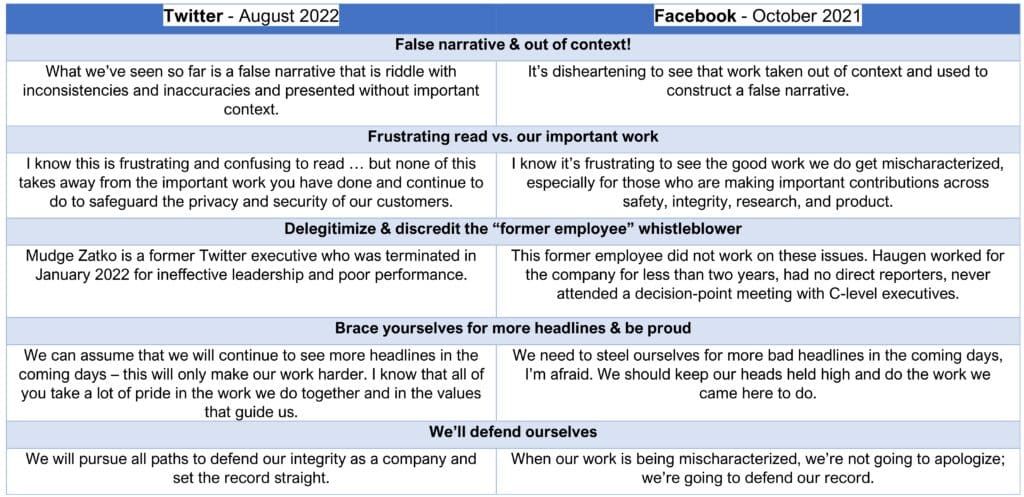The Emerging Tech PR Template for Attacking Whistleblowers
Nirit Weiss-Blatt / Aug 24, 2022Nirit Weiss-Blatt, Ph.D., is the author of The TECHLASH and Tech Crisis Communication.

Yesterday’s tech news cycle was dominated by reports about a new Twitter whistleblower, Peiter ‘Mudge’ Zatko. “Former security chief claims Twitter buried ‘egregious deficiencies,’” stated The Washington Post. CNN framed it as “Ex-Twitter exec blows the whistle, alleging reckless and negligent cybersecurity policies.”
Zatko’s methods resemble those of another (now much more famous) tech whistleblower, former Facebook product manager Frances Haugen. Haugen photographed thousands of pages of internal Facebook research reports and correspondence, releasing what became known as The Facebook Papers first to the Wall Street Journal, then to a 'consortium' of media outlets, in the fall of 2021. Her disclosures led to multiple Congressional hearings.
Like Haugen, Zatko also worked with Whistleblower Aid, a nonprofit organization led by John Tye. Following the same playbook as Haugen, Zatko and Whistleblower Aid submitted a complaint to the Securities and Exchange Commission, the Department of Justice, the Federal Trade Commission, and Congressional investigators alleging various improprieties and inconsistencies at the company. And Zatko's team secured interviews with leading media outlets for his story.
Given the similarities in the offensive strategy, it is perhaps natural that there might be some on the defensive side. Back in October 2021, in light of the Facebook Papers, Meta entered the “no more apologies” phase of its public relations stance, instead focusing on counter-attacks.
Now, it is Twitter’s turn. Its CEO, Parag Agrawal, addressed the new revelations in a company-wide response, composed of talking points he repeated today in an address to employees. His messages closely resemble Meta’s response to Haugen. I compared his wording with the statements made by Mark Zuckerberg, Nick Clegg, and Andy Stone. The companies’ responses to whistleblower allegations suggest an emerging PR Template, as both use the same five elements:
1. Claim the whistleblower is pushing a "false narrative" and the documents disclosed are out of context.
2. Suggest it is "frustrating" to read coverage that distracts from the company's "important work."
3. Delegitimize & discredit the “former employee” whistleblower.
4. Suggest employees should brace for more headlines & "be proud."
5. Assert a commitment to play defense.

Issuing the same crisis responses is not a new phenomenon- crisis PR firms advise similar language across industries. And tech platforms' responses to content moderation issues suffer from the same copy-paste mentality.
See, for example, the repetition of the PR playbook around “amplifying the good and mitigating the bad.” Or the PR standard playbook around policies: “we continually review our policies in the face of evolving threats / we worked to aggressively enforce our monetization policies ... We recognize there's more work to do, and we're committed to getting it right.”
Those of us who chronicle the companies’ statements often feel as if we live in a version of “Groundhog Day.” The response Twitter provided to its whistleblower felt familiar – because it was. We can call it “Attack The Whistleblower 101.”
But whistleblowers remain a powerful and growing force for change in the tech industry.
A day after Zatko came forward, Protocol reported that “Pinterest is under investigation by California's Civil Rights Department, and whistleblower and former Pinterest employee Ifeoma Ozoma is among those who have been contacted as possible witnesses.” Ozoma’s activism led to the passage of a law in California that makes it easier for tech employees to speak out about discrimination. So, the “Tech PR Template for Attacking Whistleblowers” does have its limitations.
Authors
